List of country subdivision flags in South America
This article needs additional citations for verification. (May 2024) |
This page lists the country subdivision flags in South America. It is a part of the Lists of country subdivision flags, which is split into continents due to its size.
Argentina
[edit]Provinces
[edit]| Flag | Administrative division | Adopted | Description | |
|---|---|---|---|---|
 |  | Buenos Aires City | 1995[1] | The center of the flag of Buenos Aires has a coat of arms created by Spaniard Juan de Garay on October 20, 1580.[2] |
 |  | Buenos Aires | 1997[3] | See Flag of Buenos Aires Province |
 |  | Catamarca | 2011[4] | See Flag of Catamarca |
 |  | Chaco | 2007[5] | A previous design from 1995 by a graphical artist was never adopted as it was deemed a painting and not a symbol.[6] |
 |  | Chubut | 2004[7] | |
 |  | Córdoba | 2014 | A vertical tricolor of red, white and blue with the Society of Jesus sun in the center of the white stripe. |
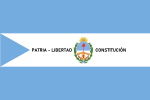 |  | Corrientes | 1986[8] | The flag traces its heritage to a simpler design created on December 24, 1821, by a Constituent Congress.[9] |
 |  | Entre Ríos | 1987[10] | It was hoisted for the first time on March 1, 1815.[11] Similar to the Artigas flag. |
 |  | Formosa | 1991[12] | |
 |  | Jujuy | 1994[13] | It features the same design as the Bandera Nacional de Nuestra Libertad Civil (Spanish for "National Flag of Our Civil Freedom"), a flag used by Argentine military leader Manuel Belgrano.[14] |
 |  | La Pampa | 1993[15] | A horizontal triband of blue (top and bottom) and white defaced with the Coat of arms of La Pampa Province at its center. |
 |  | La Rioja | 1986[16] | |
 |  | Mendoza | 1992[17] | Known as the flag of the Andes, it was used by Argentine patriot José de San Martín during his military campaigns in Chile and Peru.[18] |
 |  | Misiones | 1992[19] | A triband, officially adopted on February 12, 1992. The red is a symbol "for the blood spilled to sustain our freedom and independence", the blue, "of our decision for the Republic", and the white, "of our distinction and greatness" according to José Gervasio Artigas. |
 |  | Neuquén | 1989[20] | |
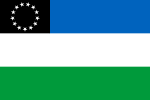 |  | Río Negro | 2009[21] | Probably based on the flag of the Kingdom of Araucanía and Patagonia. |
 |  | Salta | 1997[22] | See Flag of Salta. |
  |  | San Juan | 2018[23][24] | Known as the "Civic Flag", it was first adopted by the IV Division of the Army of the Andes, formed by San Juan natives during the Argentine war for Independence. It is also known as the "Cabot Flag" as the IV Division was led by Lieutenant General Juan Manuel Cabot. It is the only flag of an Argentine province whose reverse differs from the obverse. |
 |  | San Luis | 1988[25] | The flag displays the provincial coat of arms centered on a white field. |
 |  | Santa Cruz | 2000[26] | |
 |  | Santa Fe | 1986[27] | Used unofficially since August 3, 1822,[28] it is a vertical tricolor of red, white and blue with the provincial coat of arms in the center. |
 |  | Santiago del Estero | 1985[29] | |
 |  | Tierra del Fuego | 1999[30] | A diagonal bicolor of sky blue and orange with an albatross in the center and the Southern Cross in the fly. See Flag of Tierra del Fuego |
 |  | Tucumán | 2010[31] | A horizontal triband of white (top and bottom) and blue. |
Bolivia
[edit]Departments
[edit]| Flag | Administrative division | Adopted | Description | |
|---|---|---|---|---|
 |  | Beni | 1851 | A green field with 8 golden 5-pointed stars. |
 |  | Chuquisaca | 1851 | The Burgundy Cross with a crown in the center. |
 |  | Cochabamba | 1851 | A simple cyan field. |
 |  | La Paz | 1851 | A horizontal bicolor of red and green. |
 |  | Oruro | 1851 | A simple red field. |
 |  | Pando | 1851 | A horizontal bicolor of white and green. |
 |  | Potosí | 1851 | A bicolor quadrisection of red and white. |
 |  | Santa Cruz | 1851 | A horizontal tricolor of green (upper), white and green. |
 |  | Tarija | 1851 | A horizontal bicolor of red and white. |
Brazil
[edit]States
[edit]| Flag | Administrative division | Adopted | Description | |
|---|---|---|---|---|
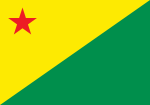 |  | Acre | 1995 | Rectangle divided by a diagonal line from the bottom left (hoist-side) to the upper right. The top left is yellow with a red star in the corner, and the bottom right is green. See Flag of Acre |
 |  | Alagoas | 1963 | A vertical tricolor of red, white, and blue, with the coat of arms of Alagoas in the centre. See Flag of Alagoas |
 |  | Amapá | 1988 | A horizontal tricolor of blue, green with black-edged white lines, and yellow, with a green triangle based on the hoist-side, bearing a stylized outline of the Fortaleza de São José de Macapá in black and white. The green triangle continues as a horizontal stripe to the fly end. See Flag of Amapá |
 |  | Amazonas | 1982 | Three horizontal stripes of equal length in white, red, and white. A blue canton over the white stripe on the hoist-side, with twenty-five five-pointed silver stars, in four rows of eight, four, four, and eight, respectively, equidistant from each other in proportion to the interior of the rectangle. In the center is a star larger than the others. See Flag of Amazonas |
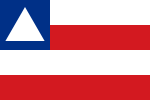 |  | Bahia | 1960 | Four alternating horizontal stripes of equal length in white and red; in the upper hoist-side canton, a white triangle on a blue field. See Flag of Bahia |
 |  | Ceará | 1922 | A green field with a large yellow rhombus in the center bearing a white disk, which contains the coat of arms of the state of Ceará. See Flag of Ceará |
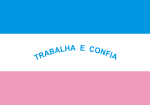 |  | Espírito Santo | 1947 | A horizontal tricolor of light blue, white, and pink; charged with "TRABALHA E CONFIA" (Portuguese for "Work and Trust"), centered on the white stripe. See Flag of Espírito Santo |
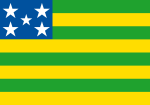 |  | Goiás | 1919 | Eight stripes: four green stripes and four yellow stripes. A blue rectangle on the upper left hoist with five white stars, four on each side and one smaller in the center. See Flag of Goiás |
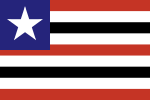 |  | Maranhão | 1889 | Nine stripes in a horizontal direction, interspersed, four white, three red and two black, with a blue canton occupying a third of the length of the flag and half of its width, in the top left with a white star in the center. See Flag of Maranhão |
 |  | Mato Grosso | 1890 | A blue banner with a white rhombus in its center which contains a green sphere and yellow star. See Flag of Mato Grosso |
 |  | Mato Grosso do Sul | 1979 | A white diagonal band radiating from the lower hoist-side corner to the top-center. The upper triangle is green and the lower triangle is blue with a yellow five-pointed star in the bottom-right corner. See Flag of Mato Grosso do Sul |
 |  | Minas Gerais | 1963 | A red triangle on a white background, surrounded by the Latin expression "Libertas quæ sera tamen" - motto of the Inconfidência Mineira, which means "Liberty, even if delayed". See Flag of Minas Gerais |
 |  | Pará | 1890 | In the field of sips (red) a silver band (white), carried in the center of a blau star (blue). See Flag of Pará |
 |  | Paraíba | 1965 | Rectangular flag striped vertically in black and red, with black occupying a third of the flag on the side of the junk, and with the inscription "NEGO" in white, with a twentieth of the width of the flag in the center of the red stripe. |
 |  | Paraná | 1892 | It is composed of a green quadrilateral, crossed from the upper left angle to the lower right by a large white stripe, bearing a blue circle with the five stars of the Southern Cross (Crux) in lower course. The Cross is depicted with south at the top, as it appears in the night sky. The circle is crossed, below the "Star of Magellan" (Estrela de Magalhães), by a thin stripe that suggests a horizon, featuring the word "PARANÁ" in green, lightened by the only visible star of that constellation. The sphere is surrounded by a branch of Paraná Pine tree — on the right, and by a branch of Yerba mate on the left. See Flag of Paraná |
 |  | Pernambuco | 1917 | A bicolor pennant, blue and white, with the colors broken horizontally into two unequal sections, with blue in the upper and larger rectangle, the rainbow composed of three colors, red, yellow and green, with a star in above and below the sun, inside the semicircle, both in yellow, and, in the lower and smaller white rectangle, a red cross. See Flag of Pernambuco |
 |  | Piauí | 1922 | Divided in thirteen interspersed green and yellow stripes with the same length. In the upper right corner there is a dark blue canton with the length equal to five stripes with a white star in the middle. Below the star, it is written with white letters: "13 DE MARÇO DE 1823" (March 13, 1823). See Flag of Piauí |
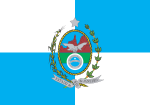 |  | Rio de Janeiro | 1965 | Field quartered in white and sky blue, in the center with the State coat of arms occupying 5/7 of the height. |
 |  | Rio Grande do Norte | 1957 | A horizontal bicolor of green and white with a ratio of 2:3. In the center it is charged with the coat of arms of Rio Grande do Norte. See Flag of Rio Grande do Norte |
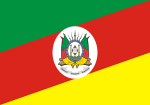 |  | Rio Grande do Sul | 1966 | Two triangles in the colors green (top left) and yellow (bottom left), which are separated by a wide red diagonal band, containing the coat of arms of Rio Grande do Sul. See Flag of Rio Grande do Sul |
 |  | Rondônia | 1981 | A blue field occupies its upper half with a central white star with five equidistant points in the middle of the banner. A green field is formed from the lower edges of the banner to the center of the lower points of the star. Two yellow fields are formed to the right and to the left of the star. See Flag of Rondônia |
 |  | Roraima | 1996 | Divided into three diagonal bands from left to right, and from bottom to top. The colors of the bands are, respectively: turquoise blue, white and flag green. Near the bottom of the flag is a narrow red band. In the center of the flag, resting on the red band, there is a gold star with dimensions that go beyond that of the central white band. See Flag of Roraima |
 |  | Santa Catarina | 1953 | Three horizontal bands in the color combination red-white-red; In the center of the flag is a green diamond containing the coat of arms of Santa Catarina. See Flag of Santa Catarina |
 |  | São Paulo | 1946 | 13 stripes of alternating black and white, with a red canton on the upper left corner. Inside the canton, a yellow star in each corner and a white circle in the middle with a blue map of Brazil. See Flag of São Paulo |
 |  | Sergipe | 1952 | Rectangle divided into four alternating green and yellow stripes, the upper one being green. In the canton (top left), a blue square whose side is half the height of the flag, loaded with five white five-pointed stars, arranged in a quincunx, with the one in the center twice the dimensions of the others. See Flag of Sergipe |
 |  | Tocantins | 1989 | A white diagonal band charged with a gold sun radiating from the lower hoist-side corner. The upper triangle is blue and the lower triangle is yellow. See Flag of Tocantins |
 |  | Federal District | 1969 | A white flag representing peace, with the green stands for the vegetation of the region and Cross of Brasília. |
Chile
[edit]Regions
[edit]| Flag | Administrative division | Adopted | Description | |
|---|---|---|---|---|
 |  | Arica and Parinacota | 2008 | White flag with the Regional Government logo in the center. |
 |  | Atacama | 1996 | A blue field with a yellow star in the center. See Flag of Atacama |
 |  | Antofagasta | ???? | Blue flag with the Regional Intendance logo |
 |  | Aysén | 2013 | White flag with the regional coat of arms in the center |
 |  | Biobío | ???? | White flag with the regional coat of arms in the center. |
 |  | Coquimbo | 2013 | Blue flag with a white star in the left down corner. To the top, in the middle, a yellow sun and a light blue sky. In the right superior side, a green land with dark green bands. |
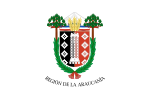 |  | La Araucanía | ???? | Three horizontal stripes (blue, white and red) with the regional coat of arms in the center. |
 |  | Los Lagos | 2013 | The flag consists of a horizontal bicolour of green and blue, with four stars resembling the shape of the Southern Cross in the canton. See Flag of Los Lagos |
 |  | Los Ríos | 2008 | The flag consists of a white background, above which are three wavy stripes yellow, green and blue, in top to bottom. These stripes are interrupted in the middle by a circle of twelve yellow stars. See Flag of Los Ríos Region |
 |  | Magallanes and Antártica Chilena Region | 1997 | The regional flag is a blue field, in the bottom of which stands a golden strip highlighting six peaks, which are covered on top by a white border. On top of these, and in front of blue background, is placed the Southern Cross on a slant and white stars. See Flag of Magallanes |
 |  | Maule | 2002 | White flag with the regional coat of arms in the center. |
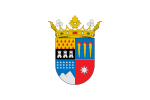 |  | Ñuble | 2018 | White flag with the regional coat of arms in the center. |
 |  | O'Higgins | ???? | White flag with the regional coat of arms in the center. |
 |  | Santiago Metropolitan Region | 2013 | Dark grey flag with the Regional Government logo in the center. |
 |  | Tarapacá | 2008 | White flag with the coat of arms of Tarapacá Region in the center. |
 |  | Valparaíso | ???? | Blue flag with the regional coat of arms in the center. |
Colombia
[edit]Departments
[edit]| Flag | Administrative division | Adopted | Description | |
|---|---|---|---|---|
 |  | Amazonas | 1974 | Rectangular defaced black-fimbriated horizontal triband tricolour of unequal sizes in green, yellow (mustard), and white, charged with an indigenous warrior charging a bow and arrow, a pouncing jaguar, and a five-pointed star all in black. See Flag of Amazonas |
 |  | Antioquia | 1962 | A horizontal bicolour of white and green. See Flag of Antioquia |
 |  | Arauca | 1979 | A horizontal bicolour of red and green. |
 |  | Atlántico | 1989 | A horizontal bicolour triband of white, red and white. |
 |  | Bolívar | 1886 | A horizontal triband of yellow, green and red. See Flag of Bolívar |
 |  | Boyacá | 1968 | A horizontal tricolour of green (first and fifth stripes), white (second and fourth stripes) and red (central stripe) with five arched Oak leaves in white centered on the red band. See Flag of Boyacá |
 |  | Caldas | ???? | A vertical bicolour of yellow and green. |
 |  | Caquetá | 1974 | Four horizontal stripes of green with the upper left corner bearing a circle of fifteen five-pointed yellow stars surrounding a single star in the centre over a white canvas. |
 |  | Casanare | ???? | Divided diagonally from the upper-fly corner to the lower-hoist corner. The upper-hoist triangle is red and the lower-fly triangle, green. At the centre of the flag is an eight pointed sun in yellow. See Flag of Casanare |
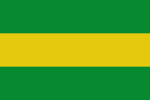 |  | Cauca | ???? | A horizontal bicolour triband of green, yellow and green. |
 |  | Cesar | ???? | A horizontal bicolour triband of green, white and green. See Flag of Cesar |
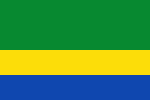 |  | Chocó | ???? | A horizontal tricolour of green, yellow and blue in a 2:1:1 ratio. |
 |  | Córdoba | 1951 | A horizontal tricolour of blue, white and green. |
 |  | Cundinamarca | 1813 | A horizontal tricolour of cyan, yellow and red with the department's coat of arms in the centre. |
 |  | Guainía | ???? | A horizontal tricolour of yellow, blue and green. |
 |  | Guaviare | ???? | A horizontal tricolour of green, white and blue with the department's coat of arms in the centre. |
 |  | Huila | 1952 | A horizontal tricolour of white, green and yellow. |
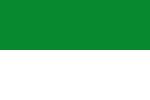 |  | La Guajira | 1966 | A horizontal bicolour of green and white. See Flag of La Guajira |
 |  | Magdalena | 1886 | Six horizontal stripes alternating between red and blue, defaced at the centre by thirty white stars forming the shape of a star. See Flag of Magdalena |
 |  | Meta | 1970 | Seventeen horizontal stripes alternating between green and white. |
 |  | Nariño | ???? | A horizontal bicolour of yellow and green. |
 |  | Norte de Santander | 1978 | A horizontal bicolour of red and black with four five-pointed yellow stars forming a rhombus. See Flag of Norte de Santander |
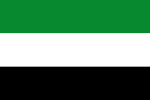 |  | Putumayo | ???? | A horizontal tricolour of green, white and black. See Flag of Putumayo |
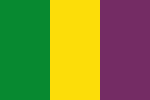 |  | Quindío | ???? | A vertical tricolour of green, yellow and purple. See Flag of Quindío |
 |  | Risaralda | 1969 | A green field with fourteen arched five-pointed white stars. |
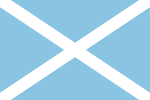 |  | San Andrés y Providencia | 1818 | A cyan field with a white saltire that extends to the corners of the flag. |
 |  | Santander | 1972 | A horizontal bicolour triband of green and black fimbriated in yellow with a red stripe in the hoist-side that has eight five-pointed white stars. See Flag of Santander |
 |  | Sucre | 1974 | A horizontal bicolour of green and white with the department's coat of arms in the centre. |
 |  | Tolima | ???? | A horizontal bicolour of dark red and yellow. |
 |  | Valle del Cauca | 1811 | A horizontal bicolour of cyan and white surrounded by a silver border. See Flag of Valle del Cauca |
 |  | Vaupés | 1984 | A horizontal bicolour of white and green with a dark green leaf in the centre. |
 |  | Vichada | ???? | A horizontal bicolour of yellow and green. |
Ecuador
[edit]Provinces
[edit]| Flag | Province | Adopted | Description | |
|---|---|---|---|---|
 |  | Azuay | ||
 |  | Bolívar | ||
 |  | Cañar | ||
 |  | Carchi | ||
 |  | Chimborazo | ||
 |  | Cotopaxi | ||
 |  | El Oro | ||
 |  | Esmeraldas | ||
 |  | Galápagos | ||
 |  | Guayas | ||
 |  | Imbabura | ||
 |  | Loja | ||
 |  | Los Ríos | ||
 |  | Manabí | ||
 |  | Morona-Santiago | ||
 |  | Napo | ||
 |  | Orellana | ||
 |  | Pastaza | ||
 |  | Pichincha | ||
 |  | Santo Domingo de los Tsáchilas | ||
 |  | Santa Elena | ||
 |  | Sucumbíos | ||
 |  | Tungurahua | ||
 |  | Zamora-Chinchipe | ||
El Salvador
[edit]Departments
[edit]| Flag | Subdivision | Adopted | Description | |
|---|---|---|---|---|
 |  | Ahuachapán | ||
 |  | Cabañas | ||
 |  | Chalatenango | ||
 |  | Cuscatlán | ||
 |  | La Libertad | ||
 |  | La Paz | ||
 |  | La Unión | ||
 |  | Morazán | ||
 |  | San Miguel | ||
 |  | San Salvador | ||
 |  | San Vicente | ||
 |  | Santa Ana | ||
 |  | Sonsonate | ||
 |  | Usulután | ||
Guyana
[edit]Regions
[edit]| Flag | Date | Use | Description |
|---|---|---|---|
 | ???? | Flag of Barima-Waini | |
 | ???? | Flag of Cuyuni-Mazaruni | |
 | ???? | Flag of Demerara-Mahaica | |
 | ???? | Flag of East Berbice-Corentyne | |
 | ???? | Flag of Essequibo Islands-West Demerara | |
 | ???? | Flag of Mahaica-Berbice | |
 | ???? | Flag of Pomeroon-Supenaam | |
 | ???? | Flag of Potaro-Siparuni | |
 | ???? | Flag of Upper Demerara-Berbice | |
 | ???? | Flag of Upper Takutu-Upper Essequibo |
Honduras
[edit]Departments
[edit]| Flag | Date | Use | Description |
|---|---|---|---|
 | Unofficial Flag of Atlántida Department | ||
 | Flag of Colón Department | ||
 | Flag of Comayagua Department | ||
 | Flag of Francisco Morazán Department | ||
 | Flag of Ocotepeque Department | ||
 | Flag of Olancho Department | ||
 | Flag of Santa Bárbara Department | ||
 | Flag of Valle Department |
Paraguay
[edit]Departments
[edit]| Flag | Date | Use | Description |
|---|---|---|---|
 | ??? – Today | Flag of Asunción | A horizontal tricolor of red (upwards), White and red with the department's arms in the center.[32] |
 | ??? – Today | Flag of Alto Paraguay | A horizontal tricolor of red, White and blue with the motto “forcé, life, prosperity” in the center. |
 | ??? – Today | Flag of Alto Paraná | A vertical tricolor of green, White and Brown. |
 | ??? – Today | Flag of Amambay | A red field with the white-edged green Nordic cross that extends to the edges; the vertical part of the cross is shifted to the hoist side. |
 | ??? – Today | Flag of Boquerón | A horizontal tricolor of blue, White and green. |
 | ??? – Today | Flag of Caaguazú | A horizontal tricolor of red, White and blue with 5 green stars in the center. |
 | ??? – Today | Flag of Caazapá | A horizontal bicolor of green and red with a white square ended on the upper hoist-side corner of the green band. |
 | ??? – Today | Flag of Canindeyú | a green with 3 bands of blue, White and red downwards. |
 | ??? – Today | Flag of Central | a White field with a red stripe and 19 blue stars. |
 | ??? – Today | Flag of Concepción | a diagonal bicolor of blue and White and a red stripe between. |
 | ??? – Today | Flag of Cordillera | Two equal horizontal bands of white (top) and green with a red-edged blue isosceles triangle based on the hoist side, a golden 12-pointed star inside the triangle and the department's arms in the center.[33] |
 | ??? – Today | Flag of Guairá | a horizontal bicolor of cyan and purple. |
 | ??? – Today | Flag of Itapúa | a horizontal tricolor of green, White and red with the department's arms in the center. |
 | ??? – Today | Flag of Misiones | a horizontal tricolor of yellow, White and green separated by two narrow stripes of red and blue and the department's arms in the center. |
 | ??? – Today | Flag of Ñeembucú | a horizontal tricolor of White, mint and blue. |
 | ??? – Today | Flag of Paraguarí | A white cross with the department's arms in the center that divides the flag into four rectangles, red and green at the top and green and red at the bottom. |
 | ??? – Today | Flag of Presidente Hayes | a horizontal tricolor of green (upwards), White and green. |
 | ??? – Today | Flag of San Pedro | a vertical tricolor of blue, White and green with the department's arms in the center. |
Peru
[edit]Departments
[edit]Provinces
[edit]Uruguay
[edit]Departments
[edit]| Flag | Date | Use | Description |
|---|---|---|---|
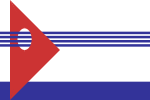 | ?-Present | Flag of The Artigas Department | |
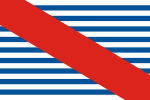 | ?-Present | Flag of The Canelones Department | [34] |
 | ?-Present | Flag of The Colonia Department | |
 | ?-Present | Flag of The Durazno Department | |
 | ?-Present | Flag of The Cerro Largo Department | |
 | ?-Present | Flag of The Río Negro Department | |
 | ?-Present | Flag of The Lavalleja Department | |
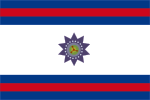 | ?-Present | Flag of The Paysandú Department | |
 | ?-Present | Flag of The Rocha Department | |
 | ?-Present | Flag of The Salto Department | |
 | ?-Present | Flag of The San José Department | |
 | ?-Present | Flag of The Soriano Department | |
 | ?-Present | Flag of The Treinta y Tres Department |
Venezuela
[edit]States
[edit]| Flag | Date | Use | Description |
|---|---|---|---|
 | 2002–present | Amazonas | Horizontal tricolor of blue, green and red with a brown outline of the state (bordered in yellow) in the center. The map is charged with seven stars spread unevenly inside the map, showing the location of the state's seven municipalities, alongside an outline of Cerro Autana and a Yanomami's face. Ratio 2:3. |
 | 1999–present | Anzoátegui | Horizontal tricolor of light blue, yellow and green with a black border outlining the state in the center and the state's coat of arms on the hoist side of the blue band. Ratio 2:3. |
 | 1996–present | Apure | Horizontal triband of yellow, blue and green; with a white triangle based at the hoist side charged with the state's coat of arms and seven white stars on the blue band. Ratio 2:3. |
 | 1993–present | Aragua | Bicolor diagonal quartered of red and yellow with the state's coat of arms in the center. Ratio 2:3. |
 | 1997–present | Barinas | Horizontal tricolor of light blue, white and green, with a red square in the center of the white band, charged with a yellow rising sun, a road of the same color and a green palm tree. Ratio 2:3. |
 | 2000–present | Bolívar | Yellow field with a green circle in the center, superposed by three horizontal blue stripes. The state's coat of arms is on the upper hoist side of the yellow field and the central blue stripe is charged with eight white stars. Ratio 110:168. |
 | 2022–present | Capital District (Caracas) | Three triangles of red, blue and red, with a white star in the center. The base of the blue triangle contains in green the shape of Waraira Repano (Cerro El Ávila). Ratio 2:3. |
 | 1995–present | Carabobo | Horizontal triband of red, blue and red again, in which the upper red band takes three fifths of the flag. The red band is charged with a yellow sun based on the fly side of the blue band. The sun is charged with the Arc of Carabobo. The upper side of the blue band is bordered by a green line. Ratio 2:3. |
 | 1997–present | Cojedes | Horizontal triband of orange, black and blue in which the orange band takes four sixths of the flag; with a blue circle charged with a yellow sun on the hoist side of the orange band. Ratio 2:3. |
 | 2004–present | Delta Amacuro | Horizontal triband of light blue, green and blue; with a white, yellow, brown and black-edged blue triangle based on the hoist, charged with a green outline of the state. The proportion of the bands is 3:2:3; and the sky blue band is charged with an arc of four white stars. Ratio 2:3. |
 | 2006–present | Falcón | Blue field with a yellow rising sun on the upper hoist side and a white moon on the lower fly side; charged with a red chief bearing the words "Muera la Tiranía Viva la Libertad" ("Death to Tyranny and long live Freedom"). Based on Francisco de Miranda's naval flag. Ratio 2:3. |
 | Unknown. First spotted in 2004 | Federal Dependencies (Probably unofficial) | Horizontal tricolor of green, white and blue, with a red fish in the center of the white band. Ratio 2:3. |
 | 1995–present | Guárico | Four horizontal bands of blue, white, yellow and green, with the state's coat of arms on the hoist side of the blue band; charged with a half-blue, half-green outline of the map bearing a cow's head sided by an ear of rice and an ear of sorghum, and an image of the Morros de San Juan. The map is surrounded by fourteen golden stars (seven on each side). Ratio 2:3. |
 | 2000–present | Lara | Two horizontal bands of red and green, the red twice the size of the green. The red band is charged with a setting sun with thirteen yellow-edged white rays based on the green band. Ratio 2:3. |
 | 1996–present | Mérida | Three triangles of green, white and light blue, with a red star in the center. The white central triangle is based on the bottom of the flag, dividing the green and light blue triangles. Ratio 2:3. |
 | 2006–present | Miranda | Horizontal tricolor of black, red and yellow, with an arc of six white stars in the center of the red band and a yellow sun on the hoist side of the black band, charged with two cocoa branches and the words "Libertad o Muerte" ("Liberty or Death"). Based on Francisco de Miranda's military flag. Ratio 2:3. |
 | 2003–present | Monagas | Light blue field superposed by three horizontal bands of blue, green and black, with a yellow sun based on the middle of the green band. The light blue field is charged with a stylized black outline of Juana Ramírez under an arc of thirteen white stars Ratio 2:3. |
 | 1998–present | Nueva Esparta | Horizontal tricolor of yellow, green and blue, in which the yellow band takes half of the flag; the green band is charged with three white stars and the yellow band is charged with a white semi-circle based on the fly side of the green band. Ratio 2:3. |
 | 1996–present | Portuguesa | Two horizontal bands of blue and green separated by a narrow white stripe; the blue band is slightly larger than the green and has a white-edged sun on its upper hoist side. Ratio 2:3. |
 | 2002–present | Sucre | Diagonal bisection of white and sky blue, with the state's coat of arms on the upper hoist side and fifteen white stars on the lower fly side. Ratio 2:3. |
 | 1997–present | Táchira | Horizontal tricolor of yellow, black and red, with two coffee branches under an arc of four white stars. Ratio 2:3. |
 | 1994–present | Trujillo | Two horizontal bands of red and white with a green triangle based on the hoist, charged with a white star bearing a pigeon. Ratio 2:3. |
 | 1999–present | La Guaira (formerly known as Vargas) | Two horizontal bands of white and blue with proportions of 3:1 on the hoist side; the white field charged with a red-edged yellow sun and the blue with four white stars. To the fly side, four vertical bands of yellow, red, white and blue. Based on the flag of José María España and Manuel Gual. Ratio 2:3. |
 | 1995–present | Yaracuy | A white diagonal band radiating from the lower hoist-side corner. The upper triangle is red, and the lower triangle is blue. On the center of the flag, a yellow sun with a circle showing a green field with brown mountains in the horizon, and a light blue sky with three white clouds. Ratio 2:3. |
 | 1991–present | Zulia | Two horizontal bands of blue and black, with a yellow sun in the center charged with a white thunder bolt. Ratio 2:3. |
References
[edit]- ^ "Bandera de la Ciudad" [Flag of the City] (in Spanish). Buenos Aires City Government. Archived from the original on 2012-10-09. Retrieved 29 December 2012.
La ordenanza N° 49669 del 31 de agosto de 1995 estableció la adopción de una bandera oficial para la Ciudad de Buenos Aires.
- ^ "Bandera de la Ciudad" [Flag of the City] (in Spanish). Buenos Aires City Government. Archived from the original on 2012-10-09. Retrieved 29 December 2012.
Adóptese como bandera oficial de la Ciudad de Buenos Aires el pabellón compuesto por fondo blanco, reproduciéndose en su centro la réplica del escudo creado por Juan de Garay el 20 de Octubre de 1580, integrado por un águila negra con su corona en la cabeza, cuatro hijos por debajo y una cruz colorada sangrienta que sale de su mano derecha.
- ^ "La Bandera Bonaerense" [The Flag of the Province of Buenos Aires] (in Spanish). Buenos Aires Province Government. Archived from the original on 1 October 2012. Retrieved 29 December 2012.
Creada por Ley 11997 el 12/08/97.
- ^ "Fue presentada la Bandera de Catamarca" [The Flag of Catamarca was presented] (in Spanish). San Fernando del Valle de Catamarca City Government. 29 August 2011. Archived from the original on 27 March 2012. Retrieved 29 December 2012.
El intendente, Ricardo Gaspar Guzmán, acompañado por su esposa, Patricia Breppe y por funcionarios de su gabinete, participó del acto de conmemoración del 190º Aniversario de la Autonomía de Catamarca, llevado a cabo en el Paseo de la Fe. En la oportunidad, fue presentada oficialmente la Bandera de la Provincia de Catamarca.
- ^ "Celebran el quinto aniversario de la Bandera del Chaco" [The fifth anniversary of the Flag of Chaco is celebrated]. La Voz del Chaco (in Spanish). Resistencia, Chaco Province. 19 September 2012. Retrieved 29 December 2012.
Finalmente habrá una reseña sobre el significado de este símbolo creado en 2007 a partir del diseño de Orlando Gadotti.
- ^ "1995 never adopted flag design". Flags of the World. Retrieved 29 December 2012.
The critics were harsh in most cases — as I told you, the designer is a graphical artist. «This flag is a painting, not a symbol» said the headline of one of the provincial daily papers. No later law abolished it, however it is not used, not shown, not talked about. It's like it never existed.
- ^ "Flag law". Flags of the World. Retrieved 29 December 2012.
The flag was made official by Law No.5292 of December 21, 2004.
- ^ "Heráldica - Bandera de la Provincia de Corrientes" [Heraldry - Flag of the Province of Corrientes] (in Spanish). Corrientes Province Government. Retrieved 29 December 2012.
En 1840 se adoptó por ley el lema "Patria, Llibertad y Constitución" que se agregó a la bandera oficializada el 24 de Diciembre de 1986 por Decreto del Poder Ejecutivo conforme a las facultades otorgadas por la Ley del 24 de Diciembre de 1821.
[permanent dead link] - ^ "Heráldica - Bandera de la Provincia de Corrientes" [Heraldry - Flag of the Province of Corrientes] (in Spanish). Corrientes Province Government. Retrieved 29 December 2012.
Fue creada por Ley del Congreso Constituyente del 24 de Diciembre de 1821 cedida a la Nación en 1826 a la bandera celeste y blanca con el sol en el centro se le agregó un pico celeste en la franja blanca con las armas de la provincia en el centro.
[permanent dead link] - ^ "Proponen el 10 de julio como día de la Bandera de Entre Ríos" [July 10 proposed as the Day of the Flag of Entre Ríos]. El Día (in Spanish). Concepción del Uruguay, Entre Ríos Province. 4 July 2011. Archived from the original on 25 April 2012. Retrieved 29 December 2012.
"Nuestra bandera no fue oficial hasta el año '87, por un decreto del Ejecutivo provincial, que en su momento presidía el gobernador (Sergio) Montiel", subrayó en diálogo con RecintoNet, y explicó que la fecha escogida obedece "al fallecimiento de Francisco Pancho Ramírez".
- ^ "El 19 de Junio, día de la bandera de Entre Ríos" [June 19, Day of the Flag of Entre Ríos]. El Heraldo (in Spanish). Concordia, Entre Ríos Province. 16 June 2011. Archived from the original on 23 April 2012. Retrieved 29 December 2012.
El primero de marzo de 1815, Entre Ríos enarboló la bandera.
- ^ "Bandera de la Provincia de Formosa" [Flag of the Province of Formosa] (in Spanish). Formosa Province Government. Retrieved 29 December 2012.
Creada por Resolución N° 36 de la Honorable Convención Constituyente el 15 de Marzo de 1.991.
- ^ "Ley Nº 4816" [Law Nº 4816] (in Spanish). Jujuy Province Government. Archived from the original on 11 February 2010. Retrieved 29 December 2012.
Sala de Sesiones, San Salvador de Jujuy, 29 de Noviembre de 1994.
- ^ "Ley Nº 4816" [Law Nº 4816] (in Spanish). Jujuy Province Government. Archived from the original on 11 February 2010. Retrieved 29 December 2012.
Adóptase a la "Bandera Nacional de Nuestra Libertad Civil", así denominada por el Cabildo de la ciudad de San Salvador de Jujuy en el acta respectiva del 25 de mayo de 1813 y que fuera entregada a éste y a su pueblo por el General Doctor Don Manuel Belgrano, como "Bandera de la Provincia de Jujuy".
- ^ "La Bandera de la Provincia de La Pampa" [The Flag of the Province of La Pampa] (in Spanish). La Pampa Province Government. Archived from the original on 2 August 2012. Retrieved 29 December 2012.
Dada en la Sala de Sesiones de la Honorable Cámara de Diputados de la Provincia de La Pampa, en Santa Rosa, a los dieciocho días del mes de noviembre de mil novecientos noventa y tres.
- ^ "Nuestros Símbolos" [Our Symbols] (in Spanish). La Rioja Province Judiciary. Archived from the original on 1 October 2012. Retrieved 29 December 2012.
Fue creada por resolución de la Convención Constituyente del 14 de Agosto de 1986.
- ^ "Será obligatorio izar la bandera de Mendoza" [It will be compulsory to raise the flag of Mendoza]. Los Andes (in Spanish). Mendoza, Mendoza Province. 5 July 2003. Archived from the original on 6 September 2012. Retrieved 29 December 2012.
En 1992 la ley 5.930 instituyó la Bandera del Ejército de los Andes, mandada a confeccionar en 1816 por el general San Martín, como emblema de todos los mendocinos.
- ^ "Será obligatorio izar la bandera de Mendoza" [It will be compulsory to raise the flag of Mendoza]. Los Andes (in Spanish). Mendoza, Mendoza Province. 5 July 2003. Archived from the original on 6 September 2012. Retrieved 29 December 2012.
El uso de la Bandera de Mendoza, la misma que usó San Martín como insignia de la campaña libertadora, será obligatorio en todo acto oficial y en cada escuela mendocina, y estará acompañando siempre a la Bandera nacional, con excepción de los actos específicos, que hagan estricta alusión a ella.
- ^ "La Bandera de Misiones" [The Flag of Misiones] (in Spanish). Misiones Province Government. Archived from the original on 19 April 2012. Retrieved 29 December 2012.
12 de febrero de 1992
- ^ "Bandera Provincial" [Provincial Flag] (in Spanish). Neuquén Province Government. Archived from the original on 1 September 2012. Retrieved 29 December 2012.
Fue adoptada en el año 1989, mediante la ley 1817/89, de la Legislatura del Neuquén
- ^ "Bandera de la Provincia de Río Negro" [Flag of the Province of Río Negro] (in Spanish). Río Negro Province Judiciary. Retrieved 29 December 2012.
27 de agosto de 2009
- ^ "Bandera de la Provincia de Salta" [Flag of the Province of Salta] (in Spanish). Salta Province Government. Archived from the original on 1 October 2012. Retrieved 29 December 2012.
Promulgada por Decreto Nº 2.663 del 14/06/97.
- ^ "Bandera de la Provincia de San Juan" [Flag of San Juan Province] (PDF) (in Spanish). Chamber of Deputies of San Juan. Retrieved 11 March 2022.
- ^ "A partir del 13 de junio, la Bandera Ciudadana encabezará los actos escolares". Sí San Juan (in Spanish). 10 June 2019. Retrieved 11 March 2022.
- ^ "Bandera de San Luis" [Flag of San Luis] (in Spanish). San Luis Province Government. Archived from the original on 3 October 2012. Retrieved 29 December 2012.
Fue adoptada como tal el 22 de Junio de 1988 bajo la Ley Provincial Nº 4810.
- ^ "Bandera de la Provincia de Santa Cruz" [Flag of the Province of Santa Cruz] (in Spanish). Santa Cruz Province Government. Retrieved 29 December 2012.
23 de Noviembre de 2000
- ^ "Description of the flag". Flags of the World. Retrieved 29 December 2012.
Re-adopted 11 September 1986.
- ^ "Escudo y bandera" [Coat of arms and flag] (in Spanish). National University of the Littoral. Retrieved 29 December 2012.
Desde el 3 de agosto de 1822 Santa Fe tiene entonces su propia enseña.
- ^ "Bandera Oficial de la Provincia" [Official Flag of the Province] (in Spanish). Santiago del Estero Province Government. Retrieved 29 December 2012.
Sala de Sesiones, Santiago del Estero, 30 de Septiembre de 1985.
- ^ "Bandera" [Flag] (in Spanish). Tierra del Fuego Province Government. Archived from the original on 15 January 2013. Retrieved 29 December 2012.
Por Decreto Nº 1794 del Gobierno de Tierra del Fuego, Antártida e Islas del Atlántico Sur, del 2 de noviembre de 1999, se aprueba el diseño del Concurso Bandera Provincial. La Ley Nº 458 sancionada el 9 de ése mes, la adopta como bandera de la provincial, oficializándola de esta manera.
- ^ "Tucumán vuelve a tener una bandera provincial" [Tucumán has a provincial flag again]. La Gaceta (in Spanish). San Miguel de Tucumán, Tucumán Province. 14 April 2010. Retrieved 29 December 2012.
La Legislatura terminó de dar de baja al estandarte que había sido creado en 1995, durante la administración democrática de Antonio Bussi. Se adoptó la misma enseña de Macha (localidad boliviana) que en la lucha contra los españoles estuvo escondida durante 72 años.
- ^ http://www.jma.gov.py/Compendio/Pdfs/Ordenanzas/ord-2001-208.pdf.
{{cite web}}: Missing or empty|title=(help) - ^ "Gobernación de Cordillera". www.gobernacioncordillera.gov.py. Retrieved 2024-04-11.
- ^ "Reinas de la vendimia zonales se preparan para la elección departamental | Intendencia de Canelones". www.imcanelones.gub.uy. Archived from the original on 2022-04-25. Retrieved 2022-04-22.


 French
French Deutsch
Deutsch



















































































































